Community Development 3: Rural-Urban Migration in Bhutan Report
VerifiedAdded on 2022/08/29
|6
|1205
|31
Report
AI Summary
This policy brief examines the critical issue of rural-urban migration in Bhutan, driven by economic development. It highlights the mass movement of people, particularly youth, from rural to urban areas, and its implications. The paper analyzes the challenges faced by Bhutanese citizens, including the lack of educational opportunities, inadequate amenities in rural areas, and limited employment prospects. It also discusses the government's current policy approach, which focuses on rural economic reconstruction and agricultural advancements. The brief recommends that policymakers adopt a more equitable approach, focusing on reducing rural poverty and providing equal opportunities in education and employment. The report also advocates for changes in population registration to address migration issues effectively. The brief uses multiple references to support its analysis and recommendations.
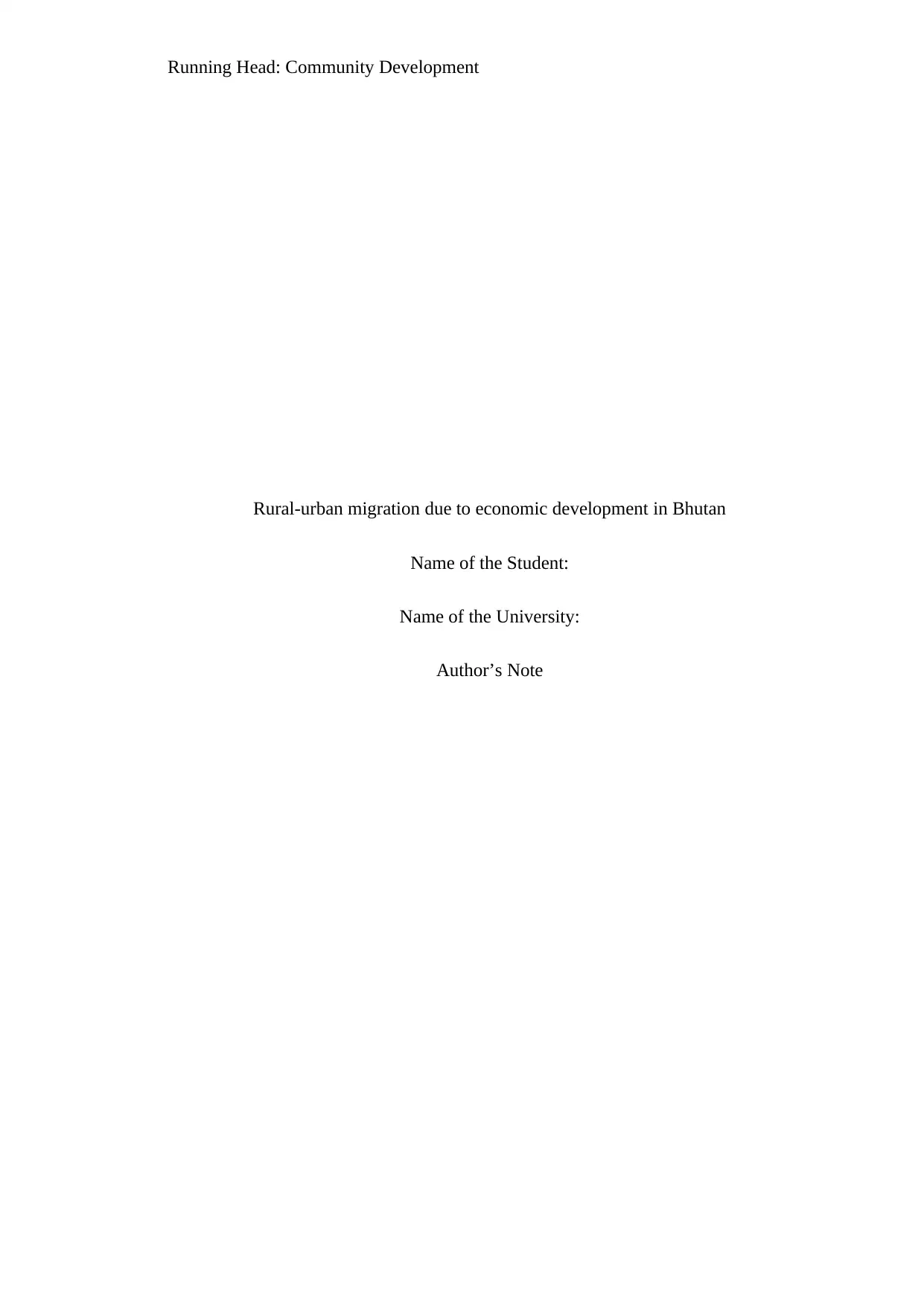
Running Head: Community Development
Rural-urban migration due to economic development in Bhutan
Name of the Student:
Name of the University:
Author’s Note
Rural-urban migration due to economic development in Bhutan
Name of the Student:
Name of the University:
Author’s Note
Paraphrase This Document
Need a fresh take? Get an instant paraphrase of this document with our AI Paraphraser
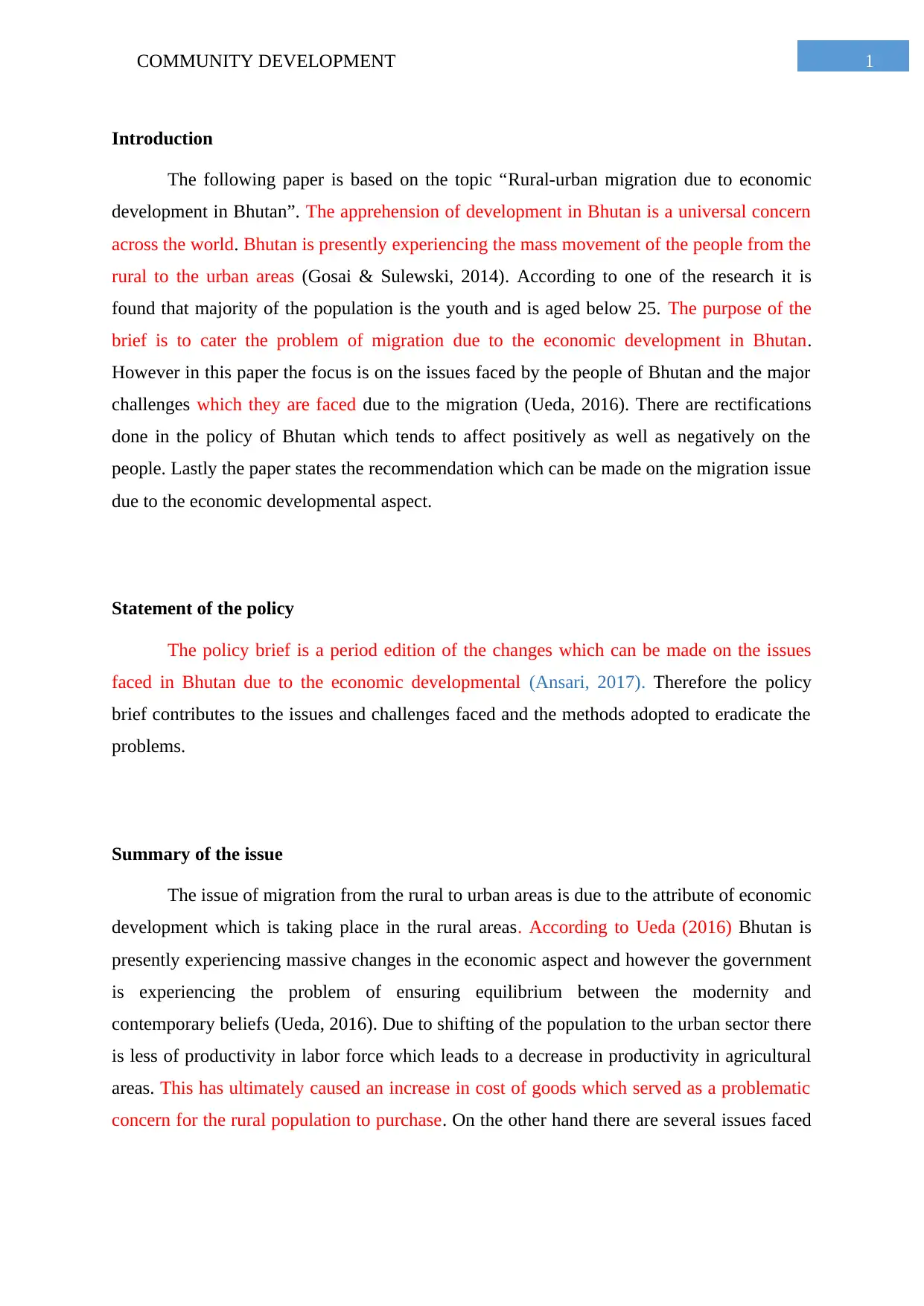
1COMMUNITY DEVELOPMENT
Introduction
The following paper is based on the topic “Rural-urban migration due to economic
development in Bhutan”. The apprehension of development in Bhutan is a universal concern
across the world. Bhutan is presently experiencing the mass movement of the people from the
rural to the urban areas (Gosai & Sulewski, 2014). According to one of the research it is
found that majority of the population is the youth and is aged below 25. The purpose of the
brief is to cater the problem of migration due to the economic development in Bhutan.
However in this paper the focus is on the issues faced by the people of Bhutan and the major
challenges which they are faced due to the migration (Ueda, 2016). There are rectifications
done in the policy of Bhutan which tends to affect positively as well as negatively on the
people. Lastly the paper states the recommendation which can be made on the migration issue
due to the economic developmental aspect.
Statement of the policy
The policy brief is a period edition of the changes which can be made on the issues
faced in Bhutan due to the economic developmental (Ansari, 2017). Therefore the policy
brief contributes to the issues and challenges faced and the methods adopted to eradicate the
problems.
Summary of the issue
The issue of migration from the rural to urban areas is due to the attribute of economic
development which is taking place in the rural areas. According to Ueda (2016) Bhutan is
presently experiencing massive changes in the economic aspect and however the government
is experiencing the problem of ensuring equilibrium between the modernity and
contemporary beliefs (Ueda, 2016). Due to shifting of the population to the urban sector there
is less of productivity in labor force which leads to a decrease in productivity in agricultural
areas. This has ultimately caused an increase in cost of goods which served as a problematic
concern for the rural population to purchase. On the other hand there are several issues faced
Introduction
The following paper is based on the topic “Rural-urban migration due to economic
development in Bhutan”. The apprehension of development in Bhutan is a universal concern
across the world. Bhutan is presently experiencing the mass movement of the people from the
rural to the urban areas (Gosai & Sulewski, 2014). According to one of the research it is
found that majority of the population is the youth and is aged below 25. The purpose of the
brief is to cater the problem of migration due to the economic development in Bhutan.
However in this paper the focus is on the issues faced by the people of Bhutan and the major
challenges which they are faced due to the migration (Ueda, 2016). There are rectifications
done in the policy of Bhutan which tends to affect positively as well as negatively on the
people. Lastly the paper states the recommendation which can be made on the migration issue
due to the economic developmental aspect.
Statement of the policy
The policy brief is a period edition of the changes which can be made on the issues
faced in Bhutan due to the economic developmental (Ansari, 2017). Therefore the policy
brief contributes to the issues and challenges faced and the methods adopted to eradicate the
problems.
Summary of the issue
The issue of migration from the rural to urban areas is due to the attribute of economic
development which is taking place in the rural areas. According to Ueda (2016) Bhutan is
presently experiencing massive changes in the economic aspect and however the government
is experiencing the problem of ensuring equilibrium between the modernity and
contemporary beliefs (Ueda, 2016). Due to shifting of the population to the urban sector there
is less of productivity in labor force which leads to a decrease in productivity in agricultural
areas. This has ultimately caused an increase in cost of goods which served as a problematic
concern for the rural population to purchase. On the other hand there are several issues faced
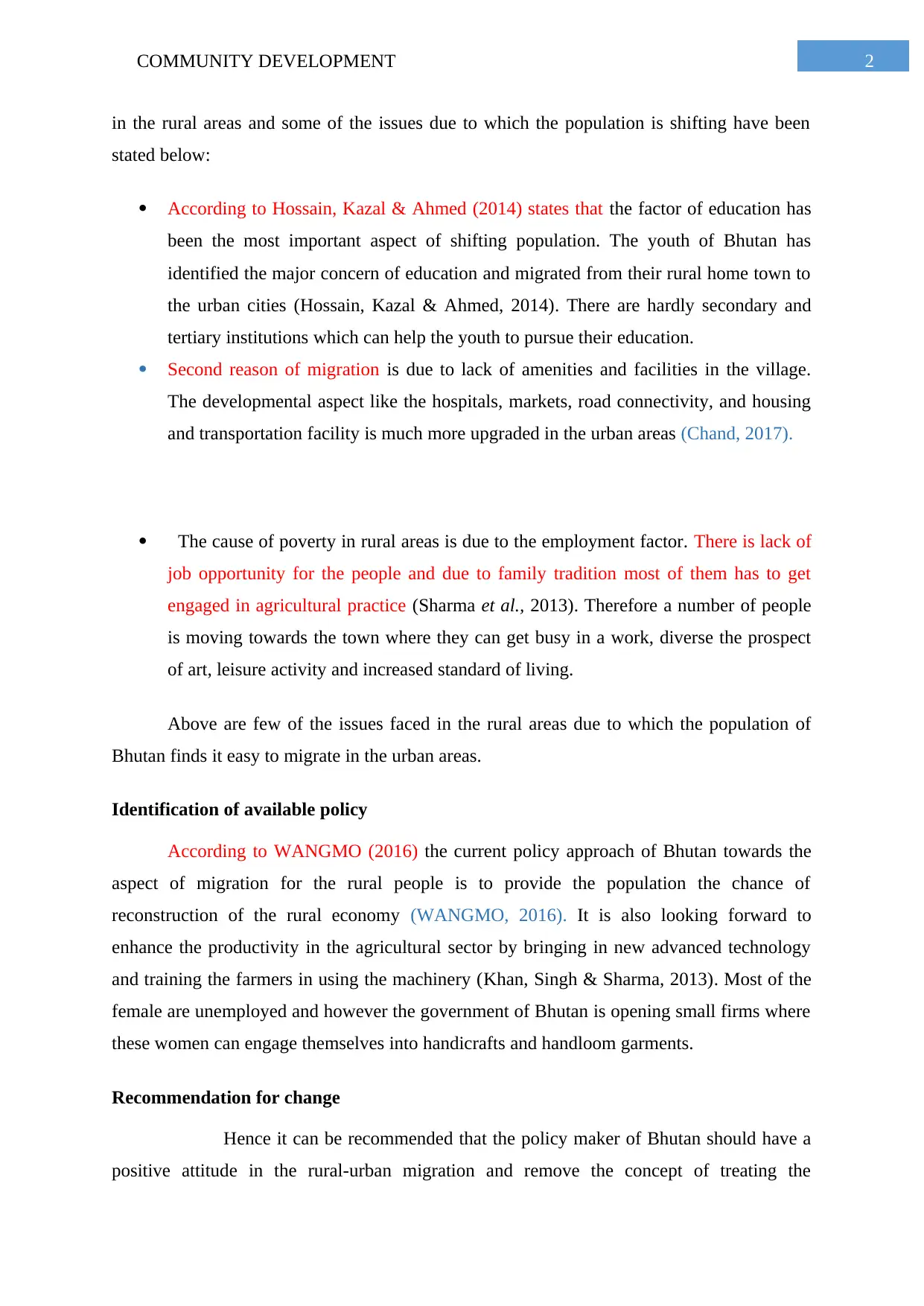
2COMMUNITY DEVELOPMENT
in the rural areas and some of the issues due to which the population is shifting have been
stated below:
According to Hossain, Kazal & Ahmed (2014) states that the factor of education has
been the most important aspect of shifting population. The youth of Bhutan has
identified the major concern of education and migrated from their rural home town to
the urban cities (Hossain, Kazal & Ahmed, 2014). There are hardly secondary and
tertiary institutions which can help the youth to pursue their education.
Second reason of migration is due to lack of amenities and facilities in the village.
The developmental aspect like the hospitals, markets, road connectivity, and housing
and transportation facility is much more upgraded in the urban areas (Chand, 2017).
The cause of poverty in rural areas is due to the employment factor. There is lack of
job opportunity for the people and due to family tradition most of them has to get
engaged in agricultural practice (Sharma et al., 2013). Therefore a number of people
is moving towards the town where they can get busy in a work, diverse the prospect
of art, leisure activity and increased standard of living.
Above are few of the issues faced in the rural areas due to which the population of
Bhutan finds it easy to migrate in the urban areas.
Identification of available policy
According to WANGMO (2016) the current policy approach of Bhutan towards the
aspect of migration for the rural people is to provide the population the chance of
reconstruction of the rural economy (WANGMO, 2016). It is also looking forward to
enhance the productivity in the agricultural sector by bringing in new advanced technology
and training the farmers in using the machinery (Khan, Singh & Sharma, 2013). Most of the
female are unemployed and however the government of Bhutan is opening small firms where
these women can engage themselves into handicrafts and handloom garments.
Recommendation for change
Hence it can be recommended that the policy maker of Bhutan should have a
positive attitude in the rural-urban migration and remove the concept of treating the
in the rural areas and some of the issues due to which the population is shifting have been
stated below:
According to Hossain, Kazal & Ahmed (2014) states that the factor of education has
been the most important aspect of shifting population. The youth of Bhutan has
identified the major concern of education and migrated from their rural home town to
the urban cities (Hossain, Kazal & Ahmed, 2014). There are hardly secondary and
tertiary institutions which can help the youth to pursue their education.
Second reason of migration is due to lack of amenities and facilities in the village.
The developmental aspect like the hospitals, markets, road connectivity, and housing
and transportation facility is much more upgraded in the urban areas (Chand, 2017).
The cause of poverty in rural areas is due to the employment factor. There is lack of
job opportunity for the people and due to family tradition most of them has to get
engaged in agricultural practice (Sharma et al., 2013). Therefore a number of people
is moving towards the town where they can get busy in a work, diverse the prospect
of art, leisure activity and increased standard of living.
Above are few of the issues faced in the rural areas due to which the population of
Bhutan finds it easy to migrate in the urban areas.
Identification of available policy
According to WANGMO (2016) the current policy approach of Bhutan towards the
aspect of migration for the rural people is to provide the population the chance of
reconstruction of the rural economy (WANGMO, 2016). It is also looking forward to
enhance the productivity in the agricultural sector by bringing in new advanced technology
and training the farmers in using the machinery (Khan, Singh & Sharma, 2013). Most of the
female are unemployed and however the government of Bhutan is opening small firms where
these women can engage themselves into handicrafts and handloom garments.
Recommendation for change
Hence it can be recommended that the policy maker of Bhutan should have a
positive attitude in the rural-urban migration and remove the concept of treating the
⊘ This is a preview!⊘
Do you want full access?
Subscribe today to unlock all pages.

Trusted by 1+ million students worldwide
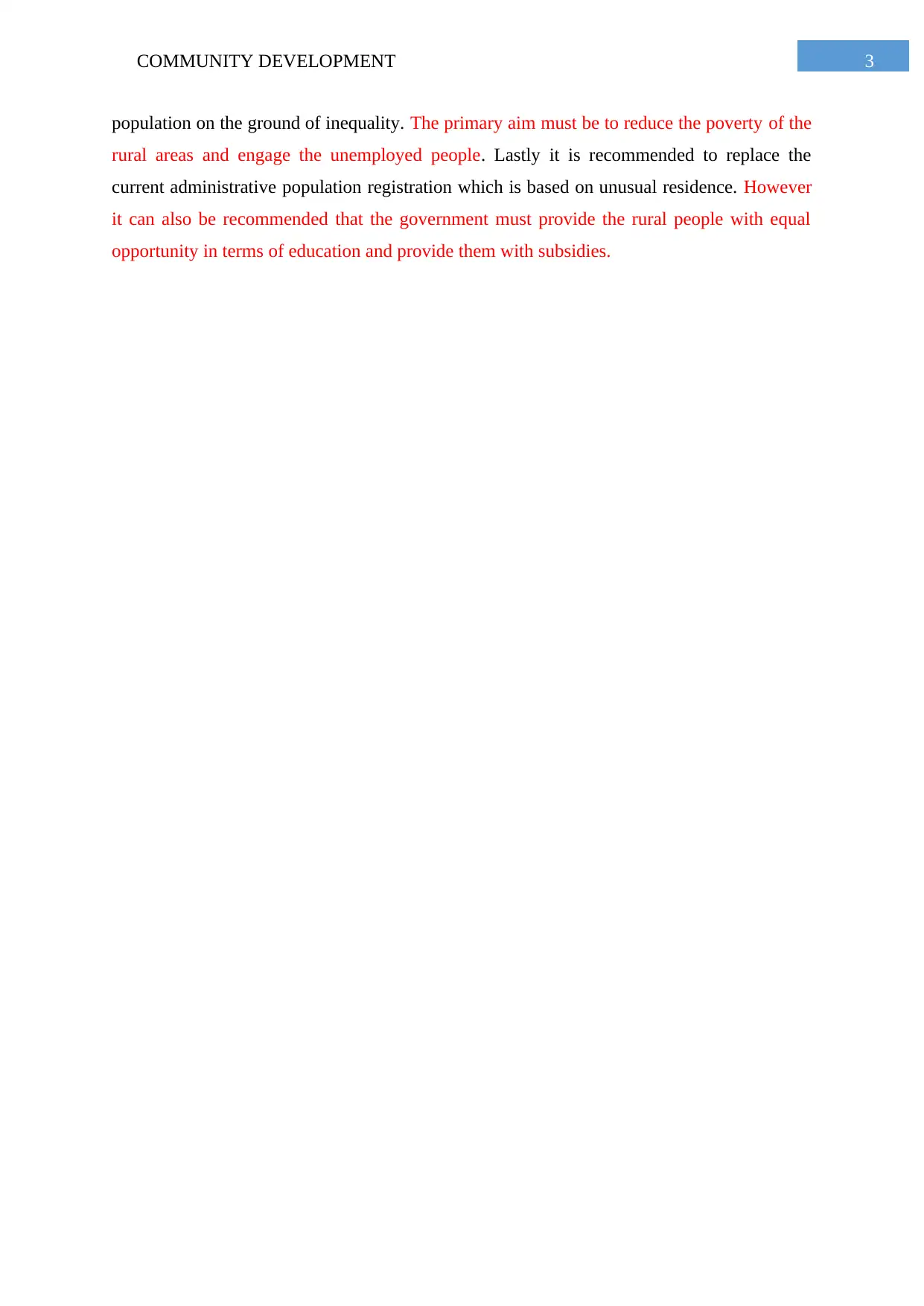
3COMMUNITY DEVELOPMENT
population on the ground of inequality. The primary aim must be to reduce the poverty of the
rural areas and engage the unemployed people. Lastly it is recommended to replace the
current administrative population registration which is based on unusual residence. However
it can also be recommended that the government must provide the rural people with equal
opportunity in terms of education and provide them with subsidies.
population on the ground of inequality. The primary aim must be to reduce the poverty of the
rural areas and engage the unemployed people. Lastly it is recommended to replace the
current administrative population registration which is based on unusual residence. However
it can also be recommended that the government must provide the rural people with equal
opportunity in terms of education and provide them with subsidies.
Paraphrase This Document
Need a fresh take? Get an instant paraphrase of this document with our AI Paraphraser
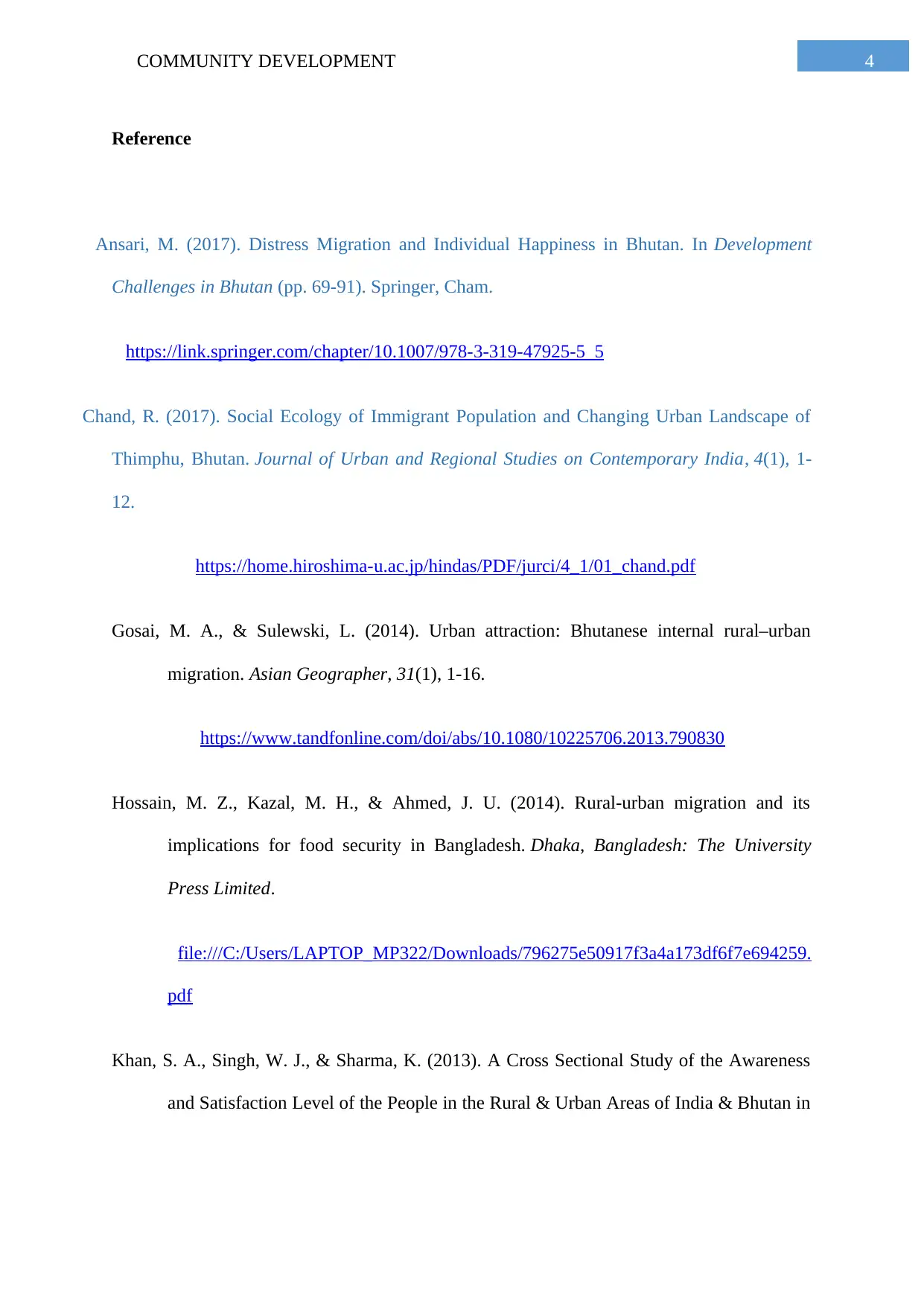
4COMMUNITY DEVELOPMENT
Reference
Ansari, M. (2017). Distress Migration and Individual Happiness in Bhutan. In Development
Challenges in Bhutan (pp. 69-91). Springer, Cham.
https://link.springer.com/chapter/10.1007/978-3-319-47925-5_5
Chand, R. (2017). Social Ecology of Immigrant Population and Changing Urban Landscape of
Thimphu, Bhutan. Journal of Urban and Regional Studies on Contemporary India, 4(1), 1-
12.
https://home.hiroshima-u.ac.jp/hindas/PDF/jurci/4_1/01_chand.pdf
Gosai, M. A., & Sulewski, L. (2014). Urban attraction: Bhutanese internal rural–urban
migration. Asian Geographer, 31(1), 1-16.
https://www.tandfonline.com/doi/abs/10.1080/10225706.2013.790830
Hossain, M. Z., Kazal, M. H., & Ahmed, J. U. (2014). Rural-urban migration and its
implications for food security in Bangladesh. Dhaka, Bangladesh: The University
Press Limited.
file:///C:/Users/LAPTOP_MP322/Downloads/796275e50917f3a4a173df6f7e694259.
pdf
Khan, S. A., Singh, W. J., & Sharma, K. (2013). A Cross Sectional Study of the Awareness
and Satisfaction Level of the People in the Rural & Urban Areas of India & Bhutan in
Reference
Ansari, M. (2017). Distress Migration and Individual Happiness in Bhutan. In Development
Challenges in Bhutan (pp. 69-91). Springer, Cham.
https://link.springer.com/chapter/10.1007/978-3-319-47925-5_5
Chand, R. (2017). Social Ecology of Immigrant Population and Changing Urban Landscape of
Thimphu, Bhutan. Journal of Urban and Regional Studies on Contemporary India, 4(1), 1-
12.
https://home.hiroshima-u.ac.jp/hindas/PDF/jurci/4_1/01_chand.pdf
Gosai, M. A., & Sulewski, L. (2014). Urban attraction: Bhutanese internal rural–urban
migration. Asian Geographer, 31(1), 1-16.
https://www.tandfonline.com/doi/abs/10.1080/10225706.2013.790830
Hossain, M. Z., Kazal, M. H., & Ahmed, J. U. (2014). Rural-urban migration and its
implications for food security in Bangladesh. Dhaka, Bangladesh: The University
Press Limited.
file:///C:/Users/LAPTOP_MP322/Downloads/796275e50917f3a4a173df6f7e694259.
Khan, S. A., Singh, W. J., & Sharma, K. (2013). A Cross Sectional Study of the Awareness
and Satisfaction Level of the People in the Rural & Urban Areas of India & Bhutan in
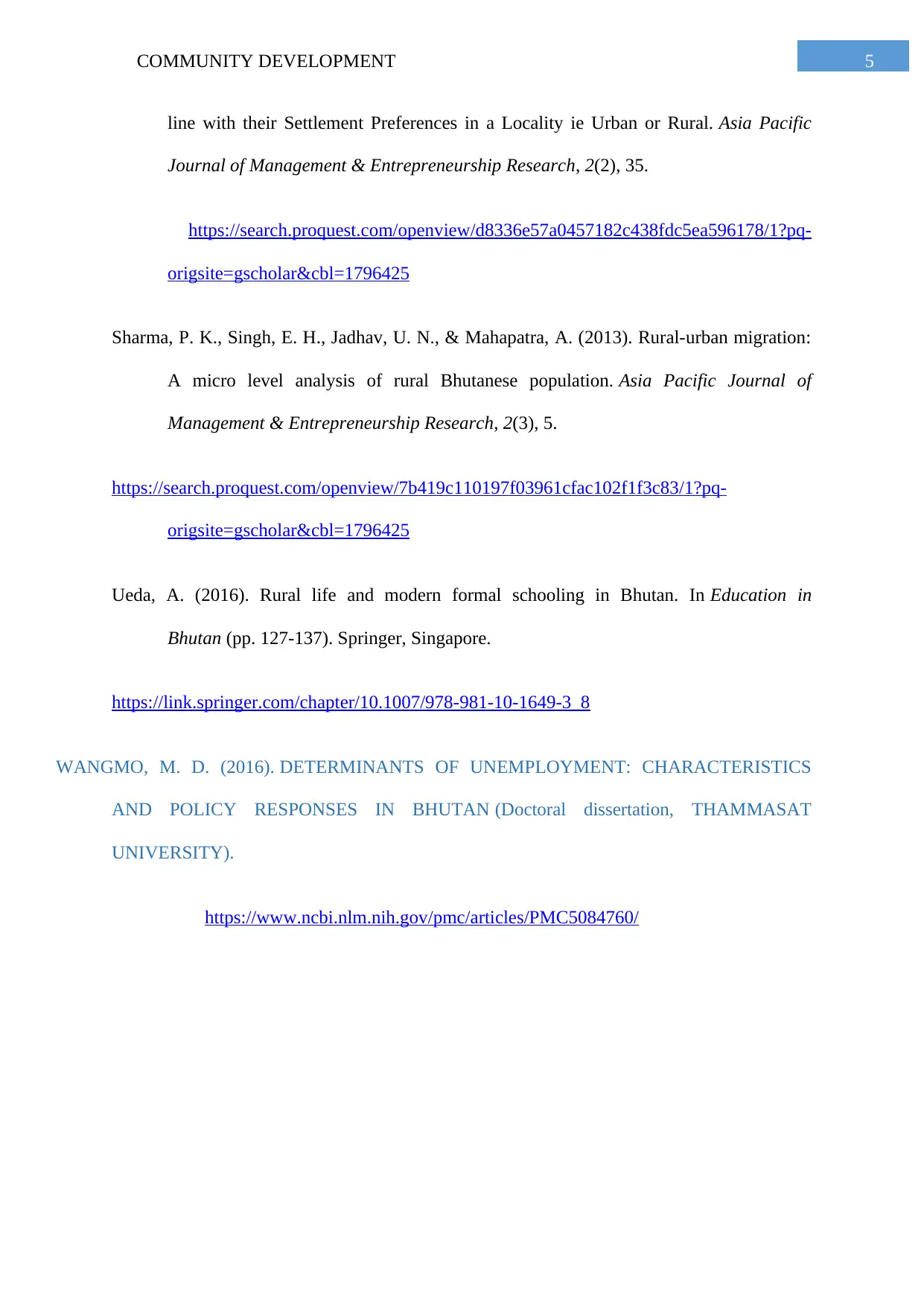
5COMMUNITY DEVELOPMENT
line with their Settlement Preferences in a Locality ie Urban or Rural. Asia Pacific
Journal of Management & Entrepreneurship Research, 2(2), 35.
https://search.proquest.com/openview/d8336e57a0457182c438fdc5ea596178/1?pq-
origsite=gscholar&cbl=1796425
Sharma, P. K., Singh, E. H., Jadhav, U. N., & Mahapatra, A. (2013). Rural-urban migration:
A micro level analysis of rural Bhutanese population. Asia Pacific Journal of
Management & Entrepreneurship Research, 2(3), 5.
https://search.proquest.com/openview/7b419c110197f03961cfac102f1f3c83/1?pq-
origsite=gscholar&cbl=1796425
Ueda, A. (2016). Rural life and modern formal schooling in Bhutan. In Education in
Bhutan (pp. 127-137). Springer, Singapore.
https://link.springer.com/chapter/10.1007/978-981-10-1649-3_8
WANGMO, M. D. (2016). DETERMINANTS OF UNEMPLOYMENT: CHARACTERISTICS
AND POLICY RESPONSES IN BHUTAN (Doctoral dissertation, THAMMASAT
UNIVERSITY).
https://www.ncbi.nlm.nih.gov/pmc/articles/PMC5084760/
line with their Settlement Preferences in a Locality ie Urban or Rural. Asia Pacific
Journal of Management & Entrepreneurship Research, 2(2), 35.
https://search.proquest.com/openview/d8336e57a0457182c438fdc5ea596178/1?pq-
origsite=gscholar&cbl=1796425
Sharma, P. K., Singh, E. H., Jadhav, U. N., & Mahapatra, A. (2013). Rural-urban migration:
A micro level analysis of rural Bhutanese population. Asia Pacific Journal of
Management & Entrepreneurship Research, 2(3), 5.
https://search.proquest.com/openview/7b419c110197f03961cfac102f1f3c83/1?pq-
origsite=gscholar&cbl=1796425
Ueda, A. (2016). Rural life and modern formal schooling in Bhutan. In Education in
Bhutan (pp. 127-137). Springer, Singapore.
https://link.springer.com/chapter/10.1007/978-981-10-1649-3_8
WANGMO, M. D. (2016). DETERMINANTS OF UNEMPLOYMENT: CHARACTERISTICS
AND POLICY RESPONSES IN BHUTAN (Doctoral dissertation, THAMMASAT
UNIVERSITY).
https://www.ncbi.nlm.nih.gov/pmc/articles/PMC5084760/
⊘ This is a preview!⊘
Do you want full access?
Subscribe today to unlock all pages.

Trusted by 1+ million students worldwide
1 out of 6
Related Documents
Your All-in-One AI-Powered Toolkit for Academic Success.
+13062052269
info@desklib.com
Available 24*7 on WhatsApp / Email
![[object Object]](/_next/static/media/star-bottom.7253800d.svg)
Unlock your academic potential
Copyright © 2020–2025 A2Z Services. All Rights Reserved. Developed and managed by ZUCOL.





